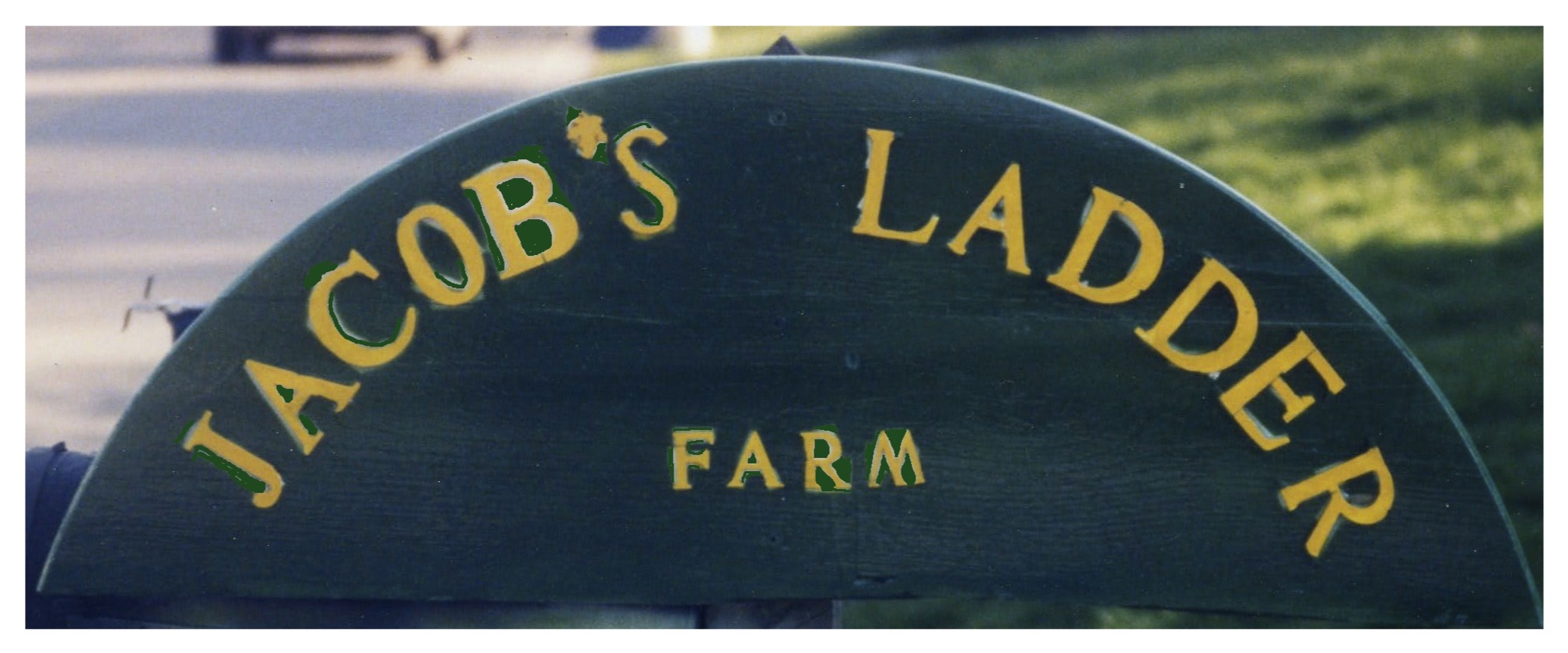ANIMALS & TORAH
Bracha Workshop
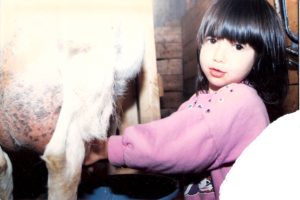
3 year old girl milking goat
Best for ages 5 & up
How the Animal World provides us with “gifts,” and how we harvest those gifts without hurting the animals we care for. Activities may include: milk a goat, shear a sheep, feel the down on a duck, learn how to hypnotize a goose for down- gathering, pluck a molting Angora bunny, balance a peacock feather, and (in season) put baby birds down for a nap!
Her best day at nursery! — Chizuk Amuno Sunday School parent, Baltimore, MD
Thank you for hosting our Bet students for the Bracha Workshop. The students really enjoyed the opportunity to discover in a hands-on manner how we receive “gifts” from animals. They came back very excited about their experiences and especially their “souvenirs.”
The workshop is a wonderful opportunity for the children to make tangible the significance and meaning of brachot, which they are studying in the classroom. We look forward to next year! — Berman-Lipavsky Religious School, Beth El Cong., Baltimore, MD
Pets Do Our Chores
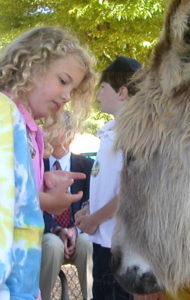
Meeting Eeyore Chamor
Best for ages 5 & up
Mankind has been given animals to help us with our yard- and farm-work. Sheep are our lawn mowers; goats, our weed whackers. Ducks mow around young trees; geese feast on orchard weeds and guard ducks and hens from foxes. Guinea fowl eat bugs, including the deer ticks that cause Lyme disease, but not produce! Guinea fowl and peacocks keep our vineyard nearly Japanese-beetle-free. Donkeys stamp shut woodchuck holes and can protect sheep from dog attacks. Chickens clean our cholent and crock pots and turn our compost piles looking for worms. Meet our furry, feathery maintenance crew and learn how each species has its own special talents at keeping plant and bug life, as well as predators, in check.
You Are Noah! (Parashat Noach)
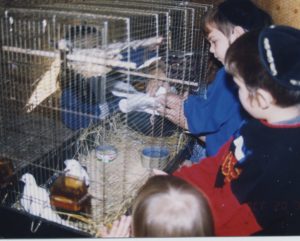
4 year olds let doves sit on their hand and then fly off, just like Noah!
Best for ages 5 & up
Learn to recognize kosher signs (“clean” and “not clean”) on sheep and goats as we become Noah and wish to know which animals will enter the Ark 2 by 2 or 7 by 7. {Play a game with life-sized hoofprints of wild and tame kosher animals, learn about cud chewing and grazing patterns, and understand how split hooves and cud chewing can save a kosher animal’s life. If the donkey is requested, predict and then test who will win a carrot-eating race: a cud-chewer or a non-cud-chewer! Examine kosher and non-kosher egg shapes and learn how a kosher bird sits!}
Next, learn not only how to feed the animals (and then feed them, as Noah had to), but also how each animal sleeps, as we will need to find each a place in the Ark to go to sleep. In season, cuddle baby birds and learn to put them down for a nap!
Finally, watch a perching experiment with doves and quail to see why Noah sent out a dove. Let a dove sit on your hand and fly off, just like Noah!
Age 4: As above, but with less direct teaching. Age 3: Feed and pet sheep and goats, stroke an Angora bunny, hold baby chicks (in season), visit doves, pet a duck’s back and tummy.
Milk & Honey
Milk a goat and then make Kick the Can Land of Milk and Honey Ice Cream
“When I told my mother I had milked a goat just like my grandmother used to demonstrate on my fingers, she had tears in her eyes” Fundraiser
“OMG! The ice cream was amazing! Life changing! Brought back childhood memories of the first time I had ice cream!” Holistic Health Practitioner
Animals of the Torah (Bible) & Talmud (Chullin)
Best for ages 5 & up
A Torah Zoo, with live exhibits of Torah and Talmud animals, including donkey, sheep, goats, doves, quail, peacocks, geese, and more; signs give background on each animal. Feed and pet select Torah animals. Tour the animals and get answers to such questions as:
Korbanot
• Which likeable but rebellious animal, singled out for use as a sin offering, can walk on its hind legs to get into trouble?
• How do you raise a petter rechem (first-born male sheep, goat, or bull) born in your backyard?
Kindness to Animals, Hakarat Ha’Tov (Recognizing the Good) & Other Jewish Values
• Who was the first person in the Torah (Bible) to make shelters for his flocks, and what name did he give the place?
• Which nonkosher animal has special status because of its Exodus help, and how much can it carry?
• Which line in Shema reminds us to feed our animals before we eat?
• How can we learn good manners by not yoking a donkey and ox together?
• Which bird is a symbol of Shalom Bayit (Peace in the Home) because the father helps sit on the eggs and raise their young?
Kosher Anatomy
• If the forelegs and hind legs of kosher animals sit directly over the two halves of the split hoof, why don’t their legs unzip and fall apart?
• Which kosher animals have horns?
• Which horns can make a kosher shofar?
Bird Questions
• Which birds don’t require the mitzva of shiluach ha’ken, and which birds require shiluach ha’ken at night but not during the day?
• Which bird, used by the metzora (ancient Israelite with a skin condition due to gossip or other lashon ha’ra ) as part of his atonement, lives in a barn but doesn’t belong to the farmer?
• How does his song help remind us to refrain from gossip?
• Why couldn’t Noah send forth a quail from the Ark?
• Which bird did Shlomo Ha’Melech (King Solomon) import from Ophir?
Portions of this workshop are based on Maor L’Masechet Chullin U’vechorot.
Thank you so much for all of your help with the Museum’s exhibition opening this past Sunday. With more than 400 people in attendance, the event was a success, and we were so pleased to see families having such a terrific time. The petting zoo was a tremendous hit with everyone. I am appreciative of all you did to make it happen. I look forward to working with you again. — Jewish Museum of Maryland, Baltimore
Thank you so much for bringing your animals and doing your presentation as part of our Lamazal Tov family event on Sept. 7. I know parents and children alike enjoyed the interaction with the animals and your talk about the shofar. I hope we have opportunities to collaborate again in the future. — Center for Jewish Education, Baltimore, MD
Living Shofars & Kosher Feet
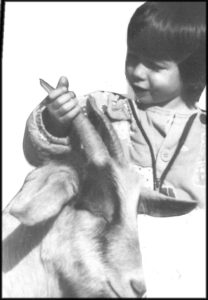
Child feeling living shofars
Best for ages 5 & up
How can you tell a kosher animal? How do cud-chewing and split hooves help save a kosher animal’s life? Which kosher animals give kosher shofars, and why? How do goats and sheep have opposite personalities, and how does this this insight make listening to the shofar very special?
Hands-on activities may include learning to feed sheep and goats, seeing split hooves and kosher mouths, feeling warm and cold parts of a live goat’s horn, and playing Shepherd and Shearer (learning sheep-calming skills and shearing a bit of wool from a live sheep).
If donkey option is included, seeing comparisons of kosher vs non-kosher feet and mouths as well as a helping with a carrot-eating race between a kosher and a non-kosher animal to see differences in how they chew.
Hands-on props include 3-D hoof-prints of wild and tame kosher animals, including elk, antelope, and bison; cow hoof showing split; sheep and goat skulls highlighting teeth configuration of kosher mouths and hollow-forming bone within shofars; horns that don’t make kosher shofars, including cow horns and a 6-foot long elk antler, which can be picked up to feel its immense weight.
Living Shofars & Kosher Feet & Make Your Own Shofar
(Highly Recommended)
Length: 45 minutes for per group of 20 or fewer children and adults for Living Shofars; plus 15-minute snack break; plus 1 hour for Make Your Own Shofar.
It was just what we wanted! — Charles E. Smith Jewish Day School, Potomac, MD
Thank you for your excellent presentation at the Center for Jewish Education’s Abraham Guy Frost Shofar Blowing Institute….Little Girl Goat was a perfect guest! Your explanations were clear, amusing, and a perfect segue for the morning’s program. I look forward to working with you and learning from you again next year! — Center for Jewish Education, Baltimore, MD
Kindness to Animals
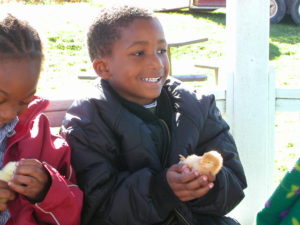
Putting chick down for a nap
All Ages
Feed animals, learn how to handle animals gently, and review our Jewish roots that promote kindness to animals. What act of kindness was our forefather Jacob the first to do? How did Moses’ compassion for a lamb usher him into his role as Shepherd of the Children of Israel? How did David’s zeal in protecting his flock, unarmed, give him the skill to slay a giant and become a national hero?
Which pasuk in the Shema reminds us to feed our animals before ourselves? Which pasuk in the Kiddush reminds us to let our animals rest on Shabbat? How can we prevent tza’ar baalei chayim to animals that need to be milked or petted on Shabbat? Learn to pet and feed a variety of friendly animals, including sheep, goats, Angora rabbit, baby birds (in season). Can be done as an add-on to You Are Noah! or The Bracha Workshop for a small fee.
CLOTH & TORAH
Sheep-to-Shawl: 9 Melachot of Cloth-Making
Ages 5 and up
Based on books by Rabbi Baruch Chait, Rabbi P. Bodner, and Dayan I. Gukovitzki; lecture-demonstration by Dayan Gukovitzki; and the annual Maryland Sheep & Wool Festival.
Hands-on; in this workshop you will do:
Gozeiz—Shearing
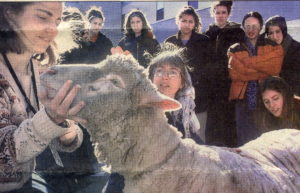
11th & 12th graders calming sheep/shearing
- Calm a sheep.
- Shear wool without hurting the sheep.
Milabein—Washing
- See an experiment of Rashi’s two types of milabein.
- Learn why fishermen needed a special type of milaben.
- Learn a theory why, in Rambam’s day, wool was cleaned using caustic chemicals instead of like Rashi.
Minapetz—Combing
Comb wool with hand cards.
 Toveh—Spinning
Toveh—Spinning
- Twist wool until it’s so strong it won’t break.
- Learn what makes wool so strong when twisted.
- Twirl a drop spindle to spin roving into yarn.
- Watch wool get spun on a spinning wheel.
Tzovei’a—Dyeing
- Learn how the plant and animal worlds differ in their uses for plant and animal fibers and dyes.
- Dye wool (if at Ptil Tekhelet, see dyeing with real tekhelet).
Meisech—Warping
- Set up a warp on a take-home mini-loom.
- Learn how many meisech threads constitute the melacha—and why!
Oseh Shtei Batei Nirin—Setting Heddles
- See why most weaving needs batei nirin.
- Use batei nirin in next step, oreig.
Oreig—Weaving
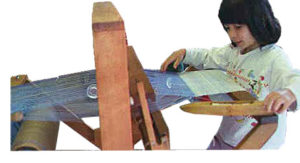
5 year old weaving on loom
- Learn how to weave the length of the mishkan’s parochet (15’-20’ long) in a 3’ space.
- Learn how to throw a boat shuttle.
- Learn how to switch yarn colors.
Potzei’a—Cutting
Learn how to remove finished cloth on your mini-loom.
It was wonderful! I have a pre-1a boy–he came home so thrilled! Each year I ask my teachers about each program, “Is it really worth the cost?” Each year my teachers say about your program, “It’s worth a million dollars!” They say they have no other way to teach the boys these melachos so clearly. We always get a very overwhelming and very good report, so keep up the good work and we’re looking forward to next year! — Principal, Torah Institute Pre-School, Owings Mills, MD
Thank you for bringing your wonderful program, “Sheep-to-Shawl,” to our school. Both the 7th grade and the 8th grade thanked me for inviting you to come to the Yeshiva. Your presentation certainly made the topic come alive for the students. Several staff members mentioned that they felt you clarified various issues for them. I look forward to inviting you back again. Your insights from Chumash, Aishes Chayil, and other parts of Tanach helped make the subject very relevant for our young women.
Thank you again for your warm and thoughtful presentation and for your sense of humor. May Hashem continue to give you the koach and creativity to do your wonderful work. — Principal, Yeshivah of Greater Washington, Silver Spring, MD
Most positive educational experience — Rambam, Baltimore, MD
The children will look back on this day and remember it far better than the 8 mishnayos they could have memorized in the same period. –Torah School, Silver Spring, MD
I’m totally blown away with what you do….Kids are still talking about it 7 years later! — Melvin J. Berman Hebrew Academy, Rockville, MD
Weave a Raised White-on-White Pattern for Cohen Clothing
Best for ages 7 & up
The priests’ linen clothing may have been of undyed linen, but they weren’t plain (according to one opinion, the design was white diamond shapes inside of white squares!). Use a skip-pattern technique to create a raised white-on-white sample. Finished size: 3 x 4.5 inches. Price includes yarn and cardboard loom, which you may keep and reuse.
Weave an Avnet Belt/Bookmark/Border
Best for ages 7 & up
The avnet was a belt for the cohanim (priests). Use a special loom to weave a sample belt or bookmark. Price includes yarn and use of looms during workshop, plus instructions on how to turn a tree branch or door knob into a working backstrap loom!
Wool, Flax, Bugs & Snails: Tapestry-Weaving for the Mishkan
Best for ages 7 & up
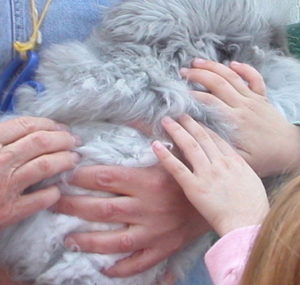
Feeling fluffy Angora bunny
Re-enact hands-on how the Children of Israel may have created beautiful Tabernacle tapestries in the Wilderness. Cut wool from a live sheep, spin wool into yarn, feel flax in the various stages of linen-making, learn about animal-derived dyes, ply 24-strand, 4-colored yarn & 28-strand, 5-colored yarn according to Rashi, weave cloth using Rashi’s “double-wall” technique. Spin and weave with tools like those pictured in Egyptian tombs. Imagine how Jewish women may have “spun the goats” (see Rashi on Shmot: 35:26) as a molting bunny sits quietly on our lap while we spin its loose wool into Angora yarn!
Portions of this workshop are based on Rashi: Shmos/Exodus, by Rabbi YIZ Herczeg; The Torah Anthology, by Meam Loez; The Living Torah, by Rabbi A. Kaplan; Prehistoric Textiles: The Development of Cloth in the Neolithic and Bronze Ages, by EJW Barber; and the Maryland Sheep & Wool Festival.
METALS & TORAH
Metals of the Mishkan: Copper & Silver (Pewter)
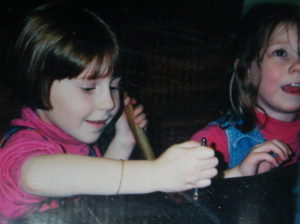
5 year olds using metal punches on copper
Best for ages 5 & up
Using photos from The Tabernacle, by Moshe Levine, learn some types of metal-working mentioned in the Torah. Shape and decorate copper using metal punches, wooden anvils and hammers, and wooden dapping blocks. Use sand-casting techniques to turn a silver-like pewter cube into a carrying ring.
Metals of the Mishkan: Iron
Best for ages 7-11 (with help) & up
Using photos from The Tabernacle, by Moshe Levine, learn some types of metal-working mentioned in the Torah, then work annealed iron by using real blacksmith tools to bend a 3-foot stainless steel rod into a dinner triangle. Feel how the metal gets hot at each bend
by your shifting the molecules and creating heat. Make a clapper to ring your triangle.
You get to keep the triangle and clapper.
Betzalel’s Workshop
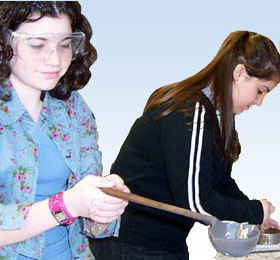
Melting cubes of pewter into rings
Wool, Flax, Bugs & Snails: Tapestry-Weaving for the Mishkan, plus Metals of the Mishkan: Copper, Iron, Silver (Pewter)
Length: 3-3 1/2 hours for each group of 20 or fewer children and adults
GEOLOGY & TORAH
Geology of Eretz Yisrael
The Holy Land…seems to reach out its hand from the confines of the Mediterranean toward the heel of the Italian “boot,” Esav’s domain (Rashi on Bereishit 27:39)….–Rabbi Elie Munk, The Call of the Torah vol 2: Genesis part 2, p 550 (Feldheim 1980)
